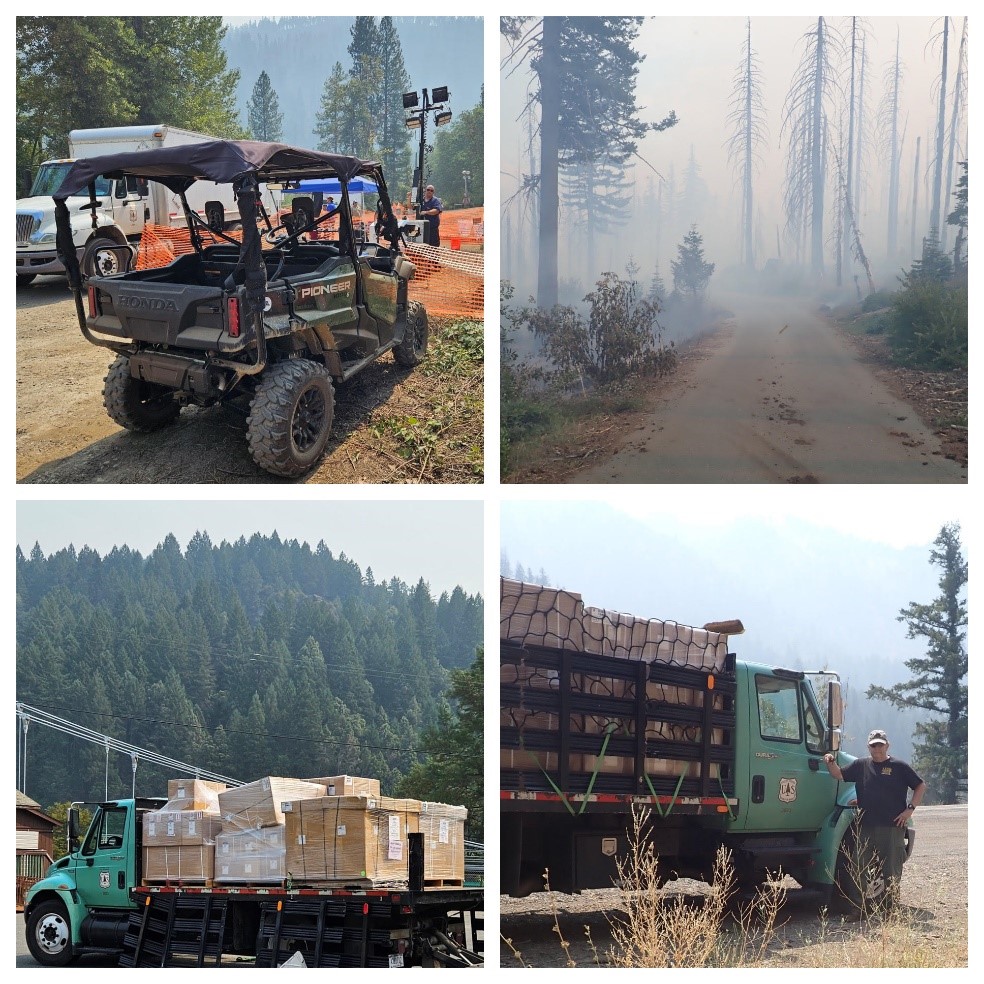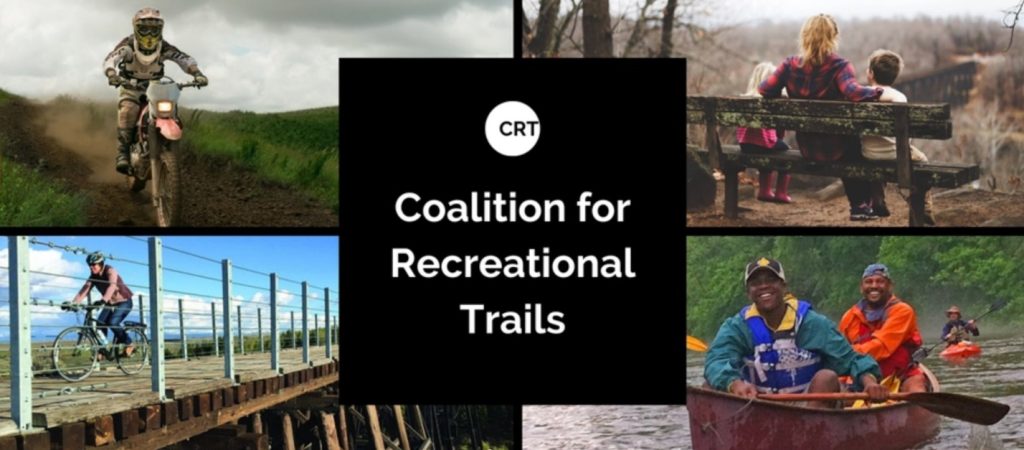(Photo credit: Mike Passo, American Trails)
ARRA Celebrates Big “Buy America” Win for RTP
Recreationists received great news when the Department of Transportation (DOT) announced on August 16 that Build America, Buy America Act provisions would no longer apply to DOT projects that cost less than $500,000. The Recreational Trails Program (RTP), which is administered by DOT’s Federal Highway Administration (FHWA), provides grants for recreational trail projects – the overwhelming majority of which cost considerably less than half a million dollars to complete. This means that relatively small RTP projects (in comparison to road and infrastructure projects) will no longer have to comply with onerous mandates that require that all iron, steel, manufactured products, and construction materials used in DOT-funded infrastructure projects be produced in the United States.
Many recent RTP projects were hampered by an inability to meet Buy America provisions as the small-scale nature of the projects meant that material costs could prove prohibitive to moving forward. Further, efforts to purchase specialty equipment, such as those used for recreational trail construction and maintenance, have been put on hold as any such equipment on the market uses more than 5% non-domestic parts in their engines and hydraulic systems. Now, RTP funds can be used for trail projects, including the purchase of specialty equipment under a general waiver for any project awarded less than $500,000.
ARRA joined many other recreation organizations that submitted comments in support of the proposed de minimis waiver, which resulted in this victory for recreational trails. In fact, in its notice, DOT highlighted the support for the waiver:
Many such comments came from stakeholders and funding recipients under FHWA’s Recreational Trails Program (RTP). Under that program, funds are apportioned to States, who then solicit and select projects to receive RTP funds as sub-awards. The DOT made it clear that this is a big win by noting that “it may be applied to both financial assistance awards and sub-awards…”
The RTP, which returns federal gasoline taxes paid by off-highway recreationists to the states for trail development and maintenance, has long been a vitally important program for motorized, non-motorized, and mixed-use trails. As such, an alliance of national and regional trail-related organizations representing motorized and non-motorized communities across a broad spectrum of interests formed the Coalition for Recreational Trails (CRT) to build awareness and understanding of the RTP.
Click here for more information about the CRT.
To learn how to nominate a completed RTP project for a CRT award, click here.

(Photo credit: Don Amador)
OHVs Play a Key Role in Wildfire Suppression Efforts
A few weeks ago, when numerous lightning strikes sparked dozens of wildfires in Northern California, Don Amador from Quiet Warrior Racing received a call from the Forest Service North Zone Fire Cache to once again serve as an emergency driver. Amador noticed, once again, the extensive use of Off-Highway Vehicles (OHVs) to haul firefighting supplies around fire camps and to remote staging to help wildfire suppression efforts by frontline crews.
As many of you know, OHVs have a long history of helping state and federal agencies aid local communities during wildfires and other natural disasters. During wildfires, they often serve by driving supplies to the incident base or running dozers to build strategic firebreaks in key areas.
OHVs also play an ever-increasingly important role in fire suppression efforts both on the front line and at the fire camp by transporting crews and supplies engaged in direct or indirect attacks or moving staff and equipment back to the supply depot.
This is now the second fire season where Amador has witnessed the prominent use of Side by Sides by private and public sector wildfire professionals during all aspects of wildfire suppression efforts in Northern and Central California.
At Quiet Warrior Racing, serving local communities – and with the assistance of our OHV recreation family – during times of crisis is a duty and a privilege that must be repaid to current and future generations.
Biden Administration Invests Nearly $11M in Wildland Fire Science Research and Knowledge Exchange
In late July, the Biden Administration announced it was investing nearly $11 million available through the Joint Fire Science Program in fiscal year 2024 for current wildland fire research priorities. This funding opportunity, supported by President Biden’s Bipartisan Infrastructure Law, can be accessed via firescience.gov and will remain open through Sept. 28.
The Bipartisan Infrastructure Law (BIL) makes critical investments of $8.25 billion to strengthen wildfire resilience efforts through the Departments of the Interior and Agriculture, including through funding for fuels management work, burned area rehabilitation, support for the federal wildland firefighting workforce, and funding for wildland fire science and research.
“The Bipartisan Infrastructure Law has been instrumental in supporting firefighter health, safety and many other wildfire management issues,” said Dana Skelly of the USDA Forest Service and chair for the Joint Fire Science Governing Board. “The Joint Fire Science program not only helps fund critical research to improve wildfire management, it also ensures that the best available science is getting to the field through our Fire Science Exchange Network.”
Thousands of research projects funded by the Joint Fire Science Program have resulted in efficient land management tools and practices. This year, the Joint Fire Science Program is soliciting proposals from both government and non-government entities in three areas: Primary, Graduate Research Innovation, and Regional Fire Science Exchange. Funding for research and science delivery will come from BIL.
Recent Bureau of Land Management Activity
- Sacramento, Calif. — The BLM awarded agreements with CAL FIRE, Caltrans, and the California Conservation Corps, to increase restoration work, fuel reduction, and forest health projects on BLM-managed public lands in California. The three cooperative agreements are being funded by President Biden’s BIL. Within the next five years, the Department of the Interior will receive $1.5 billion in BIL funding to invest in wildfire preparedness, fuels management, post-fire restoration, and fire science — with BLM California receiving more than $15 million to date. From that amount, the BLM will provide $800,000 of BIL funding to partner agencies to complete the restoration work near important infrastructure such as roads, recreation areas, and private homes. These agreements were made through the Good Neighbor Authority, which enables the BLM to collaborate with state agencies to complete projects on BLM-managed lands statewide.
- Portland, Ore. — The BLM waived recreation day-use fees for visitors on Aug. 4, in celebration of the third annual Great American Outdoors Day. The BLM invited all communities to explore the unique and diverse natural landscapes and recreation facilities available on their public lands throughout Oregon and Washington. Within Oregon and Washington, the BLM’s standard amenity day-use fees were waived at the following: Yaquina Head Outstanding Natural Area, Cape Blanco Lighthouse, Wildwood Recreation Site, Hyatt Lake Recreation Area, Gerber Recreation Area, Yakima River Canyon, Loon Lake Recreation Site, Alsea Falls Recreation Site, Shotgun Creek Recreation Site, Edson Creek Recreation Site, and Spring Recreation Site.
- Anchorage, Alaska – Secretary of the Interior Deb Haaland announced a Public Land Order opening about 812,000 additional acres of public lands managed by BLM Alaska to selection by eligible Alaska Native Vietnam-era veterans under Sec. 1119 of the John D. Dingell, Jr. Conservation, Management, and Recreation Act of 2019. The Alaska Native Vietnam-era Veterans Land Allotment Program allows eligible individuals to select an allotment of up to 160 acres from available federal lands in Alaska. The secretary opened 27 million acres to selection in August 2022. With the opening of these additional lands, there are now approximately 29.5 million acres of available federal lands open for selection by eligible Alaska Native Vietnam-era Veterans. The 812,000 acres made available were not included in the August 2022 announcement, as the state of Alaska holds top filings on them. Subsequently, some Alaska Native Vietnam Veterans expressed interest in parcels among that acreage, which led to the secretary’s action.
- Bishop, Calif. – The BLM announced fire restrictions effective July 31 for all public lands managed by the Bishop Field Office. The expanded seasonal restrictions are necessary due to increasing dry conditions and wildland fire danger. These restrictions are in addition to the year-round statewide fire prevention order, issued on April 28, 2020. This seasonal fire orderwill remain in effect until further notice.
- Nevada – Because of drying vegetation, increasing daytime temperatures and some human-caused fires, the BLM; Carson City District Office; the Bureau of Indian Affairs, Western Nevada Agency; Bureau of Reclamation, California – Great Basin Region; Nevada Division of Forestry, Public Domain Allotments; and the U.S. Fish & Wildlife Service, Stillwater National Wildlife Refuge Complex announced the implementation of fire restrictions on all lands under their jurisdiction effective, July 29, and lasting until further notice.
- Salmon, Idaho–The BLM, U.S. Department of Agriculture’s Forest Service, and Idaho Department of Lands implemented Stage 1 fire restrictions, effective July 28, to reduce the risk of wildfire. Stage 1 fire restrictions apply to federal, state, state endowment, private forestland, and rangelands in east-central Idaho.
- Gunnison, Colo. – The BLM implemented a temporary closure to all public use for 978 acres of public land in Gunnison Field Office, from Cunningham Gulch north to Mill Creek Road (Gunnison County Road 727). Gunnison Field Manager Jon Kaminsky issued the Temporary Closure Order in response to the Low line Fire, actively burning in Gunnison National Forest about 14 miles north-northwest of Gunnison and 11 miles southwest of Crested Butte in Gunnison County, Colo. The BLM closure provides for increased public safety and enables firefighters to focus on suppression efforts and will remain in effect until firefighting operations are completed, and safe public access is ensured.
- Buffalo, Wyo. – Because of dry conditions and high fire danger, Stage 1 fire restrictions began on Aug. 1 on public lands managed by the BLM in Campbell County. The BLM is working with the county to coordinate restrictions. Violation of this Fire Prevention Order is punishable by a fine of not more than $100,000, imprisonment of not more than 12 months, or both. (43 CFR 9212.4 and 18 U.S.C. 3571). Restitution for total suppression and damage costs incurred will be borne by the violator.
- Fairbanks, Alaska— Because of ongoing wildland fire activity associated with the Lost Horse Creek Fire (#296), the BLM’s Eastern Interior Field Office evacuated and closed the western portion of the White Mountains National Recreation Area surrounding the Wickersham Dome Trailhead at mile 28 Elliott Highway. The closure will remain until Sept. 1 unless modified.
- Roswell, N.M. – With increasing precipitation and higher humidity, resulting in reduced fire danger, the BLM Roswell Field Office has terminated fire restrictions at the Ft. Stanton-Snowy River Cave National Conservation Area and the Lincoln Tracts in Lincoln County, N.M. This action rescinds Fire Prevention Order # LLNMP02310-2023-001.
- Kanab, Utah —The BLM published a Notice of Availability and opened a 90-day public comment period for the Draft Resource Management Plan (RMP) and Environmental Impact Statement (EIS) for the Grand Staircase-Escalante National Monument, which would replace the existing 2020 Record of Decision and Approved Resource Management Plans for the Grand Staircase-Escalante National Monument and 2020 Record of Decision and Approved Resource Management Plan for the Kanab-Escalante Planning Area that together guide the management of approximately 1.87 million acres of public lands. The comment period closes Nov. 9.
- Santa Fe, N.M. – The BLM’s New Mexico State Office announced that it has awarded a new financial assistance agreement to New Mexico Countiesfor community wildfire risk reduction, planning, and outreach. The more than $1.2 million award is using funds from the Bipartisan Infrastructure Law to improve the wildfire resiliency of our nation’s lands and protect homes and businesses from increasingly extreme fire seasons being driven by climate change.

